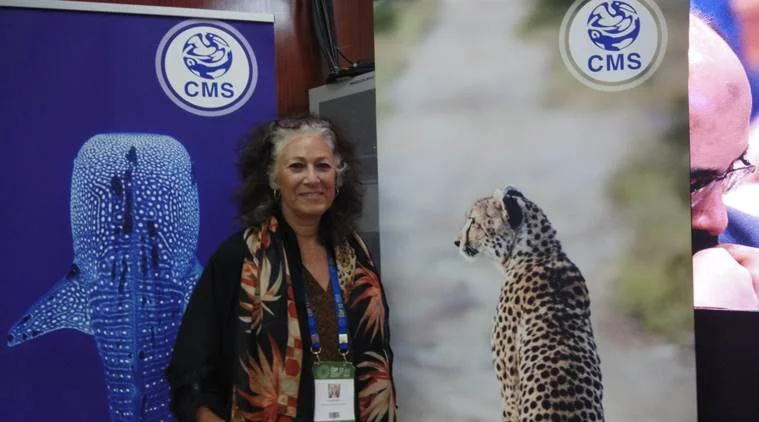 The reintroduction of cheetahs in India can be very useful for the species, and obviously very important for the biodiversity of India’s grassland ecosystems, an expert explains.
The reintroduction of cheetahs in India can be very useful for the species, and obviously very important for the biodiversity of India’s grassland ecosystems, an expert explains.
What are the global trends in cheetah population, now around 7,500?
The reintroduction of cheetahs in India, there are 31 cheetah populations spread in 23 countries and we all know that population is declining due to human cause at this point in time, like human-wildlife conflict, decline of prey, loss of habitat, illegal wildlife trade etc. For example, in Namibia, a small CITES quota exists of cheetahs as legal trophy-hunting, and possibly up to 200 more are removed by farmers as laws there say that you can take the animal if there is fear of loss of life or property. Plus, the illegal trade is coming from the Horn of Africa where cubs would be snatched from the wild, their mother is either killed or not killed…
What role does Cheetah Conservation Fund (CCF) play in Namibia?
We did baseline work to understand their home ranges, population densities, understand how cheetahs live, what is causing their loss etc. They, as any other predators, would prefer prey rather than livestock. So, it is important to maintain that balance to have enough prey for the predators… Getting rid of predators can actually causes more problems, as it opens up territories and other dispersal animals come into the open territory. For instance, research has shown that removing jackals actually increases the jackal population due to their reproductive behaviour. The more you kill jackals, the higher is the jackal population. In Namibia, farmers have learned that, ‘I shouldn’t take this animal out as other dispersal animals will fill the territory and come from far and wide to fill it.’ The reintroduction of cheetahs in India
In Namibia, there are still issues, but the government is aware that cheetahs are the one species that is being affected by human-wildlife conflict and everybody is making plans. Education is key. In 30 years of CCF being in Namibia, we have worked with 650,000 school students. Some of our students are now the people running the government now…We have stabilised the population in Namibia. There are an estimated 1,500 adult and adolescent cheetahs.
If India goes ahead with its plan to reintroduce the cheetah, what will be the factors at play?
We appreciate that Indian is exploring the option of reintroducing cheetahs. If India is willing to give it a try, it can be very useful for the species, and obviously very important for the biodiversity of India’s grassland ecosystems and helping cascade facts as to what a top predator can do in helping other species which are in that ecosystem, like the Indian bustard and the caracal, both needing help for their own survival.
It is true that India is a different continent from Africa, but then cheetahs are very adaptable. Just what we know from international captive facilities and breeding programmes, cheetahs are adaptable. But today cheetahs need places to live in the wild. India is providing an opportunity of a new landscape, a landscape which can also assist other species within. It is going to assist the biodiversity here in the country as well. Cheetahs are not aggressive animals. So, they are not going to eat people… The reintroduction of cheetahs in India
If communities manage their livestock well, and there is a wildlife preybase, there are arid landscapes here in India that are perfect for cheetah. At the same time, cheetahs are also found in a variety of landscape throughout its range there in Africa, from thorn-bush Savannah to arid Savannah. India’s prey base is also very similar… But you have to have more than just hares as a preybase, because hares are not going to feed a mother with cubs.
How can India address such issues?
Put them in a proper habitat and then create awareness, supporting research projects, and realise that it is going to take a number of years to re-establish populations. Look at the population support that has gone on in the United States for species like the California condor. It was nearly extinct. That programme is ongoing for 40 years and, after 40 years, now we can call it successful. We think about things in a short period of time because, remember we are in a fast lane these days, everything is about fast. Cheetahs are fast too, but its reestablishment is going to be long-term and it’s not going to be fast. We hope that all of India would support this interesting long-term experiment for the betterment of India, its people and its wildlife.
Have there been such relocation experiments elsewhere?
There’s been a lot of reintroductions in southern part of Africa. Last year, our colleagues reintroduced cheetah up into Malawi where they were extinct… The Malawi project is still ongoing. Things take time. Extinction takes time and bringing the species back takes more time and more money… But in India, they have a will and a way, they have the roadmap, they have ideas and I believe it’s really worthwhile to try to see what happens.
Laurie Marker, settled in Namibia, is the founder of Cheetah Conservation Fund and serves on the IUCN’s Species Survival Commission’s Cat Specialist Group. She spoke to Gopal Kateshiya in Gandhinagar.
Source: Indian Express|
For more details : Ensemble IAS Academy Call Us : +91 98115 06926, +91 7042036287
Email: [email protected] Visit us:- https://ensembleias.com/
#india #prime_minister #narendra_modi #government #E-commerce #consumersafety #robust #marketplace #technology #solutions #policy #blog #current_affairs #daily_updates #free #editorial #geographyoptional #upsc2020 #ias #k_siddharthasir #ensembleiasacademy





